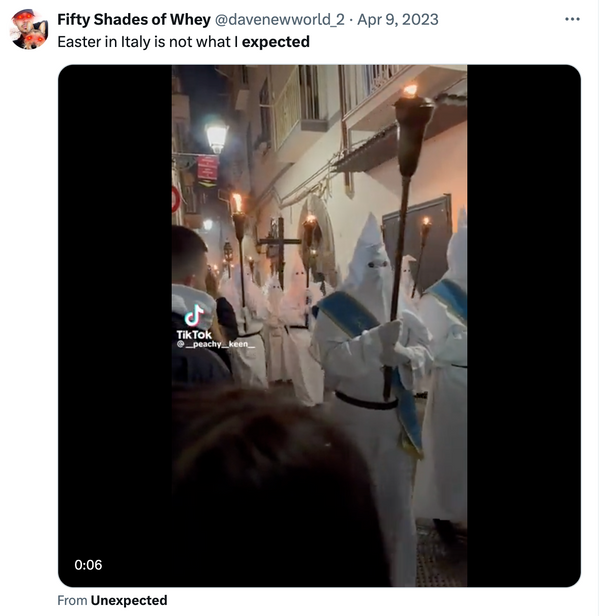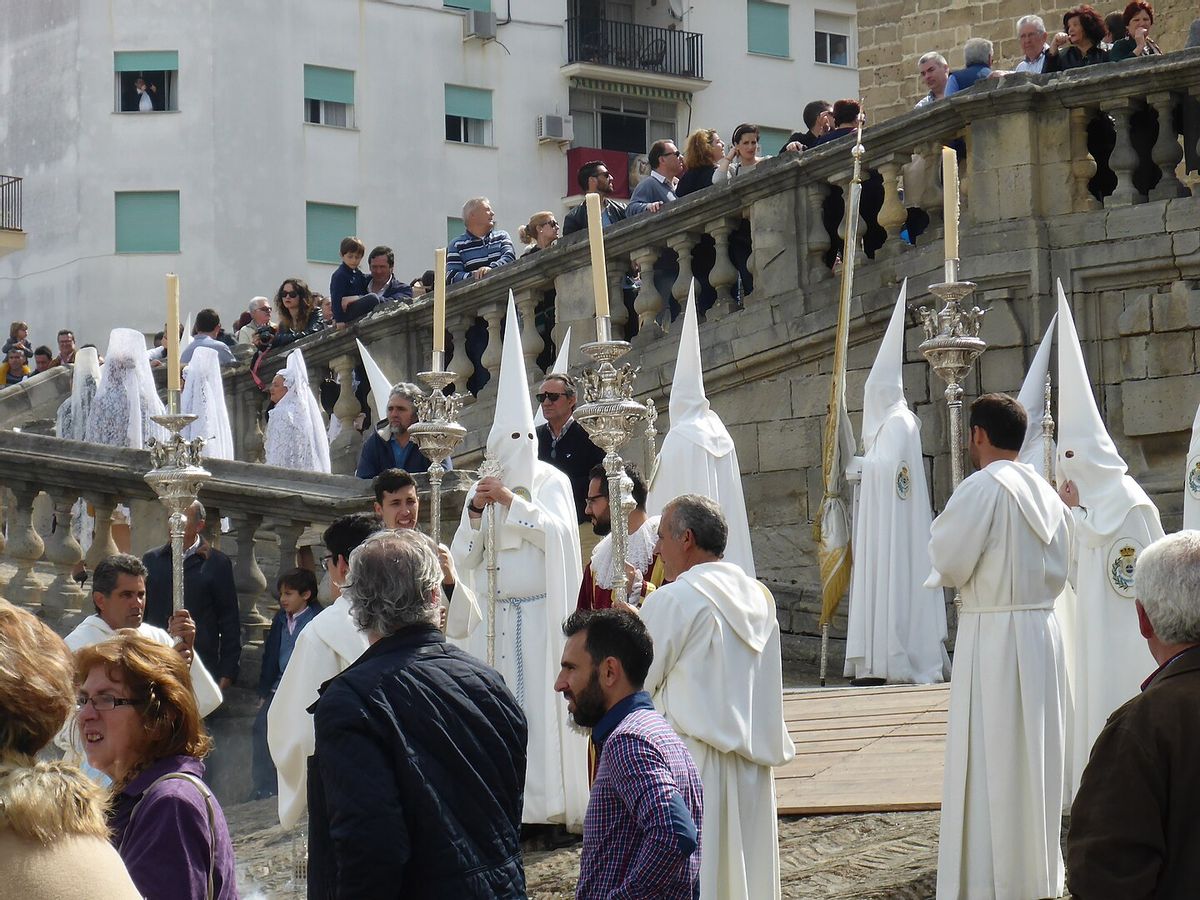In late March 2024, near the time the Christian holiday of Easter was observed, a European Easter tradition went viral on social media. A number of posts appeared to show Spanish and Italian Easter traditions, depicting people walking in robes with pointed hoods that, to many, looked eerily similar to the hoods traditionally worn in the U.S. by white supremacist group the Ku Klux Klan.
An X post from March 2024 said, "I like Catholic Easter, there are people walking on the streets with KKK crosses, masks, etc. Just kidding, that's in the USA , here in Europe the dress code derives from Monastic life."
A year earlier, in 2023, a post on X said "Easter in Italy is not what I expected," and shows hooded figures walking down a street as a Black woman watches with a perturbed expression on her face.
 (X user @davenewworld_2)
(X user @davenewworld_2)
Other posts claimed that such hoods were a "medieval Catholic tradition" in Spain and represent "contrition and repentance." This post argued that the KKK just copied these outfits:
These hooded robes do appear to be a fixture over Easter in Spain and Italy, but they have little or nothing to do with the KKK, according to numerous sources. Nor is it clear whether the KKK copied the hoods from European traditions or came by the idea via another route.
Referred to as the "capirote" in Spain, the pointed hoods are believed to date back as far as the Spanish Inquisition, according to the BBC. Worn by penitents to hide their identities, the hood was historically meant to be a mark of humiliation and was given to those who had been singled out by the church for violating doctrine. It was then adopted by Catholic brotherhoods to be worn voluntarily to disguise the identities of flagellants — people who flagellate themselves as penance for their sins. They are now worn during Semana Santa, or Holy Week, in Spain.
A 2019 story from the Spanish news outlet El País reported how in the city of Cádiz, Spain, a shopkeeper selling figurines with the hoods had anticipated uncomfortable questions about the KKK and had put up a sign reading, "No Ku Klux Klan. Spanish tradition."
"Many tourists think this. When there aren't many people in the shop, I show them a video of a procession so they can see the difference," the shopkeeper explained. "Many tourists from cruise ships pass by here. There are some who know what Semana Santa is about, but there are others who don't. They look at you as if you're crazy when they see the figurines. And it doesn't only happen with Americans. There are also, for example, Argentines who ask if they represent the Ku Klux Klan."
Photographs of Spanish penitents have often been used incorrectly on social media to represent the KKK. An American baseball player once confused them with the KKK on his social media, and the BBC reportedly used an incorrect image of Spanish penitents in an article about the KKK.
Similar looking robes are also present in Italy, where in certain towns "flagellanti" strike their backs with various materials in processions during Holy Week. These penitents also wear hoods to disguise their identities from others in their community in what is considered a highly personal religious experience.
But did the Klan use these European hoods as inspiration for their official outfits? It isn't clear. The cone-shaped headgear of the KKK has long represented racism and bigotry in the U.S., but in the early days of the Klan they didn't really have a set uniform. They wore fake beards, animal horns, paper hats, and pointed hats suggestive of wizards or dunces, according to The New Republic, drawing on carnival traditions, minstrelsy, and the Southern festival of Mardi Gras.
For Alison Kinney, the author of "Hood," the earliest representation of these hoods as the uniform of the KKK was in the 1915 film "The Birth of a Nation" (emphasis ours):
In 1915, director D. W. Griffith adapted The Clansman as The Birth of a Nation, one of the very first feature-length films and the first to screen in the White House. Its most famous scene, the ride of the Klan, required 25,000 yards of white muslin to realize the Keller/Dixon costume ideas. Among the variety of Klansman costumes in the film, there appeared a new one: the one-piece, full-face-masking, pointed white hood with eyeholes, which would come to represent the modern Klan. Maybe it was Griffith who brought those pieces of fabric together in their soon-to-be iconic form; after all, his mother had sewn costumes for his Klansman father. Or, given the heterogeneity of Reconstruction Klan costumes, maybe Griffith got the idea from another source altogether: Freemason regalia. Or maybe it wasn't Griffith's idea at all, but that of Paris-trained, Costume Designer Guild's Hall-of-Famer Clare West, who worked on the film: maybe she had witnessed confraternal processions in the streets of Europe, or just made it up.
In 1921, the Klan mass-produced regalia that looked much as it was presented in "The Birth of a Nation."
Michael Jerryson, professor of religious studies at Youngstown University, on the other hand, argued that the Klan directly appropriated the capirote, and their use of Christian symbolism was apparent throughout their handbook.
Regardless of where the KKK drew their inspiration for the hoods, the meaning of this regalia is totally different in Spain and other European countries, where it is worn around Easter in religious observances. Today, the outfits exist in separate contexts, though their visual similarities are striking.
